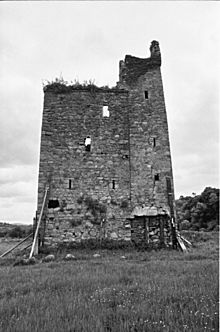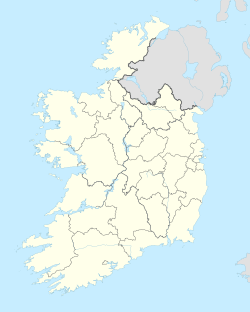Dysart Castle facts for kids
Quick facts for kids Dysart Castle |
|
|---|---|
| County Kilkenny, Ireland | |

Castle ruins
|
|
| Coordinates | 52°30′07″N 7°07′18″W / 52.5020111°N 007.1215444°W |
| Type | Medieval castle |
| Site information | |
| Condition | Ruin, in need of restoration |
| Site history | |
| Built | 14th century |
Dysart Castle is an old castle that is now in ruins. It is located just outside Thomastown in County Kilkenny, Ireland. This castle is famous because it was the childhood home of George Berkeley. He was an important Irish philosopher. Places like Berkeley, California and the Berkeley Library at Trinity College Dublin are named after him. Today, the castle is privately owned and needs a lot of repair work.
Contents
Discovering Dysart Castle's Past
Dysart Castle is found south of Thomastown. It sits low by a sharp bend in the River Nore. This area once had a medieval church, the castle, and other buildings. The church was once connected to the castle. Later, they became separate properties, about 21 feet apart.
How the Castle Looked
Dysart Castle was not very big. It was built in a simple style. A stone arch divided the inside. There was a path on the second floor that led into the church.
Early History of the Land
In 1193, the land and buildings of Dysart were given to the Priory of Kells. This was a type of monastery. The records from that time suggest the place was called Dysart of St. Mo-Colm-óg, or Colman. This means St. Colman was seen as the special protector of the area. The church, castle, and surrounding land belonged to the Priory of Kells. This continued until 1540, when the priory was closed down.
George Berkeley's Home
While it's not certain if George Berkeley was born at Dysart Castle in 1684, he definitely grew up there. His family home was right next to Dysart Castle. This makes the castle an important part of his early life story.
Uncovering Secrets: Archaeology at Dysart
In the 2000s, an archaeologist named Ben Murtaugh led a dig at Dysart. He had help from the Royal Irish Academy. His team found the remains of three stone buildings above ground. They were all close to each other. The dig showed four main periods of activity at the site.
The Earliest Times
The first period was about an early medieval monastery and church. This was linked to St. Colman. During this time, there was a stone church, a graveyard, and a round house. They also found old stone crosses and pieces of Romanesque art.
The Priory's Influence
The second period saw the site become a farm or outpost for the Augustinian Priory of Kells. This was from about 1200 to 1540. During this time, the church was made bigger. A tower house (which is what Dysart Castle is) was built. The graveyard also continued to be used.
After the Monks Left
The third period happened after the graveyard was no longer used for burials. The church was also no longer used for worship. It seems the church was changed into a barn or outhouse. A long dwelling house was also built south of the tower house. This was the time when George Berkeley grew up there.
Saving Dysart Castle
Today, Dysart Castle is seen as a "romantic ruin." This means it's beautiful but falling apart. In 2003, The Irish Times newspaper asked for urgent help to save the castle. They warned that new cracks in the walls meant it could "imminently collapse." Some work had been done before with help from the Kilkenny County Council and private efforts. The castle still needs a lot of care to keep it from disappearing completely.


